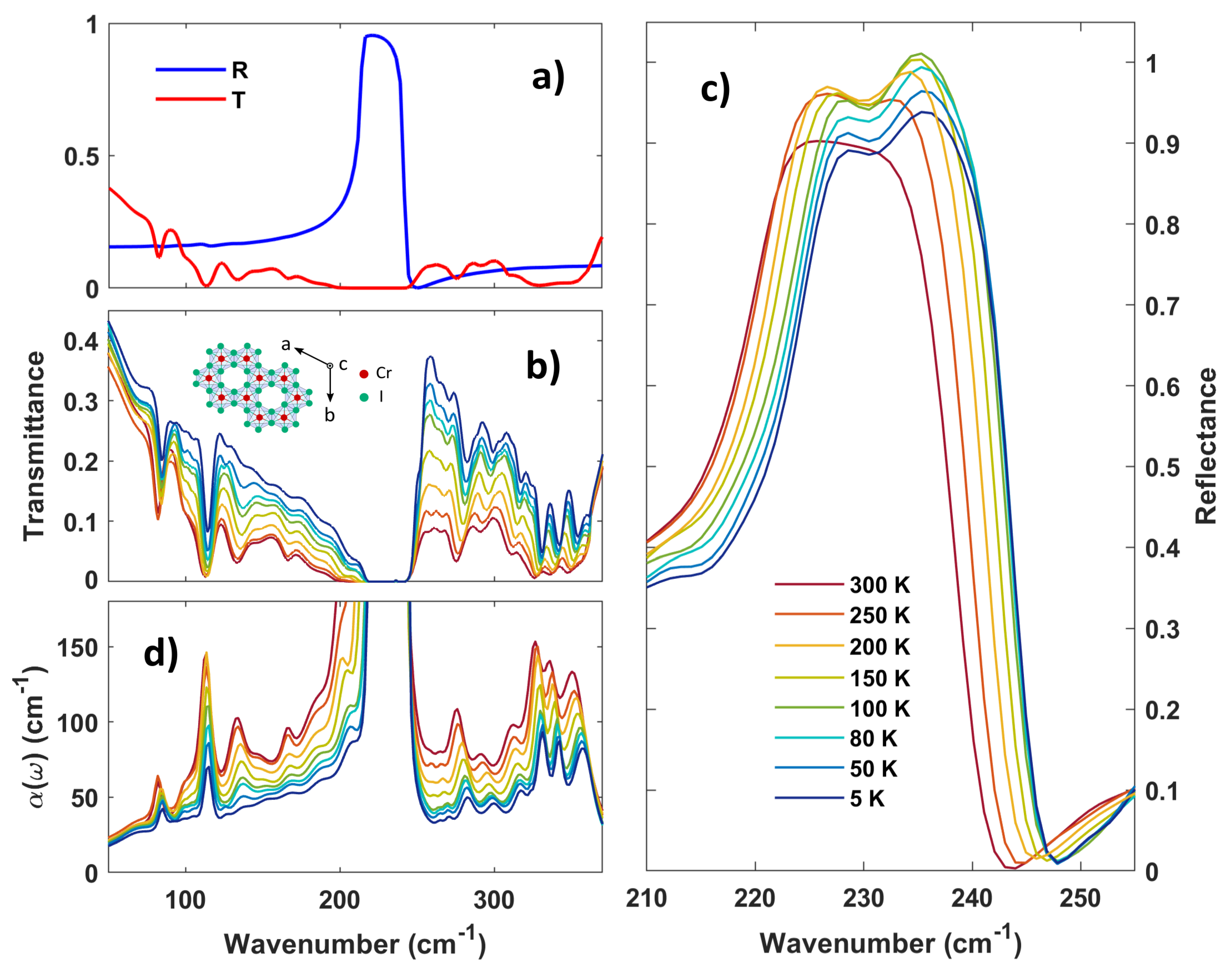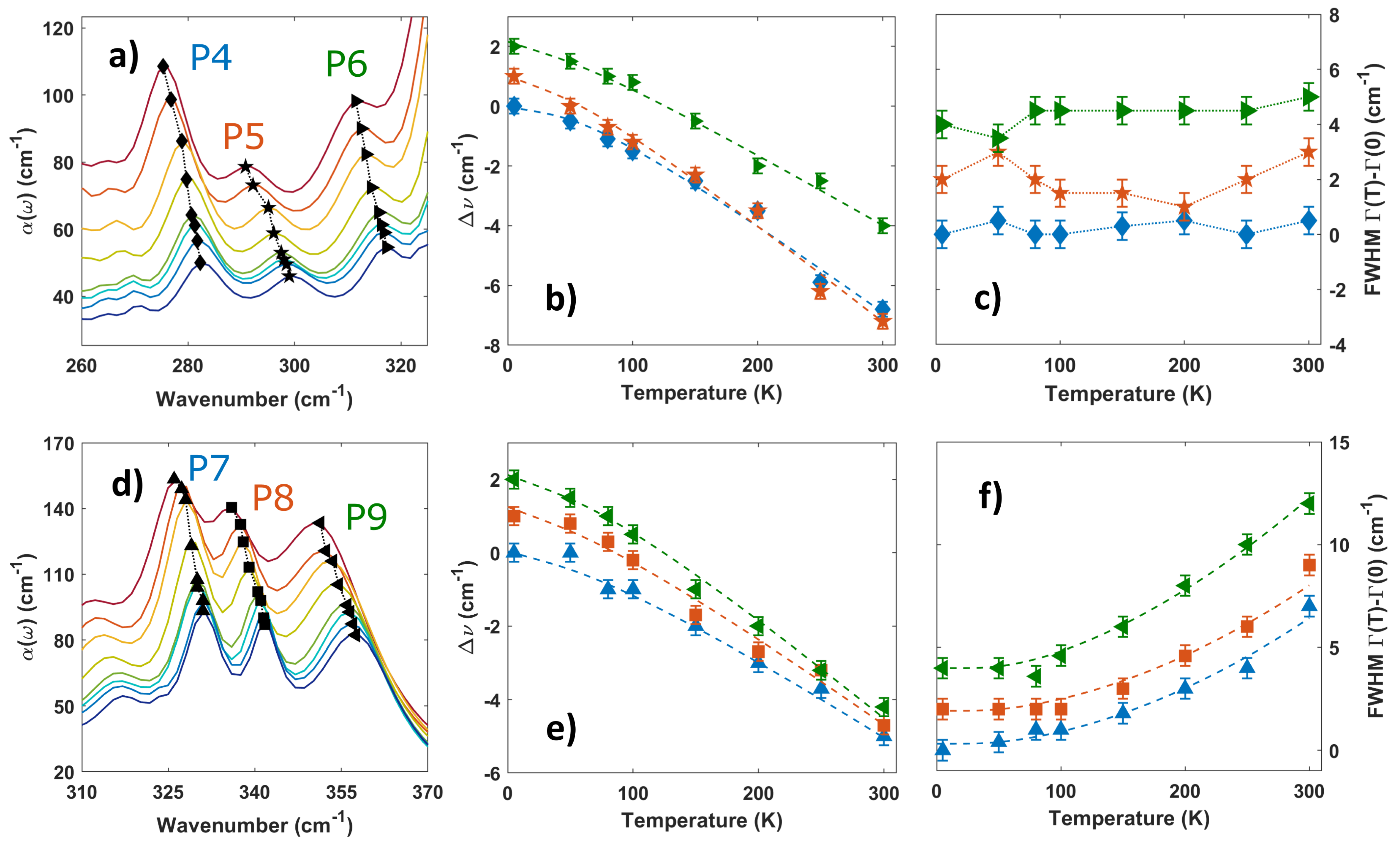Phonon Anharmonicity and Spin–Phonon Coupling in CrI3
Abstract
1. Introduction
2. Materials and Methods
Models for Anharmonic Phonon Scattering
3. Results
4. Discussion
Phonon Anharmonicity
5. Conclusions
Author Contributions
Funding
Institutional Review Board Statement
Informed Consent Statement
Data Availability Statement
Conflicts of Interest
References
- Wang, Q.H.; Kalantar-Zadeh, K.; Kis, A.; Coleman, J.N.; Strano, M.S. Electronics and optoelectronics of two-dimensional transition metal dichalcogenide. Nat. Nanotechnol. 2012, 7, 699–712. [Google Scholar] [CrossRef] [PubMed]
- Manzeli, S.; Ovchinnikov, D.; Pasquier, D.; Yazyev, O.V.; Kis, A. 2D transition metal dichalcogenides. Nat. Rev. Mater. 2017, 2, 17033. [Google Scholar] [CrossRef]
- Reedijk, J.; Poeppelmeier, K. Comprehensive Inorganic Chemistry II: From Elements to Applications; Elsevier: Amsterdam, The Netherlands, 2013. [Google Scholar]
- Liu, C.W.; Östling, M.; Hannon, J.B. New materials for post-Si computing. MRS Bull. 2014, 39, 658–662. [Google Scholar] [CrossRef]
- Lemme, M.C.; Li, L.-J.; Palacios, T.; Schwierz, F. Two-dimensional materials for electronic applications. MRS Bull. 2014, 39, 711–718. [Google Scholar] [CrossRef]
- Radisavljevic, B.; Radenovic, A.; Brivio, J.; Giacometti, V.; Kis, A. Single-layer MoS2 transistors. Nat. Nanotechnol. 2011, 6, 147–150. [Google Scholar] [CrossRef]
- Mak, K.F.; Shan, J. Photonics and optoelectronics of 2D semiconductor transition metal dichalcogenides. Nat. Photonics 2016, 10, 216–226. [Google Scholar]
- Felser, C.; Fecher, G.H.; Balke, B. Spintronics: A Challenge for Materials Science and Solid-State Chemistry. Angew. Chem. 2007, 46, 668–699. [Google Scholar]
- Schaibley, J.R.; Yu, H.; Clark, G.; Rivera, P.; Ross, J.S.; Seyler, K.L.; Yao, W.; Xu, X. Valleytronics in 2D materials. Nat. Rev. Mater. 2016, 1, 16055. [Google Scholar] [CrossRef]
- Dillon, J.F.; Kamimura, H.; Remeika, J.P. Magneto-optical properties of ferromagnetic chromium trihalides. J. Phys. Chem. Solid 1966, 27, 1531–1549. [Google Scholar] [CrossRef]
- Wang, H.; Eyert, V.; Schwingenschlögl, U. Electronic structure and magnetic ordering of the semiconducting chromium trihalides CrCl3, CrBr3, and CrI3. J. Phys. Condens. Matter 2011, 23, 116003. [Google Scholar] [CrossRef]
- Niu, B.; Su, T.; Francisco, B.A.; Ghosh, S.; Kargar, F.; Huang, X.; Lohmann, M.; Li, J.; Xu, Y.; Taniguch, T.; et al. Coexistence of Magnetic Orders in Two-Dimensional Magnet CrI3. Nano Lett. 2020, 20, 553–558. [Google Scholar]
- Tokura, Y.; Yasuda, K.; Tsukazaki, A. Magnetic topological insulators. Nat. Rev. Phys. 2019, 1, 126–143. [Google Scholar] [CrossRef]
- Chang, C.-Z.; Zhang, J.; Feng, X.; Shen, J.; Zhang, Z.; Guo, M.; Li, K.; Ou, Y.; Wei, P.; Wang, L.-L.; et al. Experimental Observation of the Quantum Anomalous Hall Effect in a Magnetic Topological Insulator. Science 2013, 340, 167–170. [Google Scholar] [CrossRef] [PubMed]
- Jackeli, G.; Khaliullin, G. Mott Insulators in the Strong Spin-Orbit Coupling Limit: From Heisenberg to a Quantum Compass and Kitaev Models. Phys. Rev. Lett. 2009, 102, 017205. [Google Scholar] [CrossRef]
- Knolle, J.; Kovrizhin, D.L.; Chalker, J.T.; Moessner, R. Dynamics of a Two-Dimensional Quantum Spin Liquid: Signatures of Emergent Majorana Fermions and Fluxes. Phys. Rev. Lett. 2014, 112, 207203. [Google Scholar] [CrossRef]
- Pershan, P.S. Magneto-Optical Effects. J. Appl. Phys. 1967, 38, 1482. [Google Scholar] [CrossRef]
- Freiser, M. A survey of magneto-optic effects. IEEE Trans. Magn. 1968, 4, 2. [Google Scholar] [CrossRef]
- Haider, T. A Review of Magneto-Optic Effects and its Application. Int. J. Electromagn. Appl. 2017, 7, 17–24. [Google Scholar]
- Seyler, K.L.; Zhong, D.; Klein, D.R.; Gao, S.; Zhang, X.; Huang, B.; Navarro-Moratalla, E.; Yang, L.; Cobden, D.H.; McGuire, M.A.; et al. Ligand-field helical luminescence in a 2D ferromagnetic insulator. Nat. Phys. 2018, 14, 277–281. [Google Scholar] [CrossRef]
- Liu, Z.; Guo, K.; Hu, G.; Shi, Z.; Li, Y.; Zhang, L.; Chen, H.; Zhang, L.; Zhou, P.; Lu, H.; et al. Observation of nonreciprocal magnetophonon effect in nonencapsulated few-layered CrI3. Sci. Adv. 2020, 6, 43. [Google Scholar] [CrossRef]
- McGuire, M.A.; Dixit, H.; Cooper, V.R.; Sales, B.C. Coupling of Crystal Structure and Magnetism in the Layered, Ferromagnetic Insulator CrI3. Chem. Mater. 2015, 27, 612–620. [Google Scholar]
- Liu, Y.; Wu, L.; Tong, X.; Li, J.; Tao, J.; Zhu, Y.; Petrovic, C. Thickness-dependent magnetic order in CrI3 single crystals. Sci. Rep. 2019, 9, 13599. [Google Scholar] [CrossRef] [PubMed]
- Webster, L.; Liang, L.; Yan, J.-A. Distinct spin–lattice and spin–phonon interactions in monolayer magnetic CrI3. Phys. Chem. Chem. Phys. 2018, 20, 23546–23555. [Google Scholar] [CrossRef]
- Zhang, Y.; Holder, T.; Ishizuka, H.; de Juan, F.; Nagaosa, N.; Felser, C.; Yan, B. Switchable magnetic bulk photovoltaic effect in the two-dimensional magnet CrI3. Nat. Commun. 2019, 10, 3783. [Google Scholar] [CrossRef] [PubMed]
- Pollini, I. Electron correlations and hybridization in chromium compounds. Solid State Commun. 1998, 106, 549–554. [Google Scholar] [CrossRef]
- Bermudez, V.M.; McClure, D.S. Spectroscopic studies of the two-dimensional magnetic insulators chromium trichloride and chromium tribromide—I. J. Phys. Chem. Solids 1979, 40, 129–147. [Google Scholar] [CrossRef]
- Jin, W.; Kim, H.H.; Ye, Z.; Ye, G.; Rojas, L.; Luo, X.; Yang, B.; Yin, F.; Shih An Horng, J.; Tian, S.; et al. Observation of the polaronic character of excitons in a two-dimensional semiconducting magnet CrI3. Nat. Commun. 2020, 11, 4780. [Google Scholar] [CrossRef]
- Sun, Z.; Yi, Y.; Song, T.; Clark, G.; Huang, B.; Shan, Y.; Wu, S.; Huang, D.; Gao, C.; Chen, Z.; et al. Giant nonreciprocal second-harmonic generation from antiferromagnetic bilayer CrI3. Nature 2019, 572, 497–501. [Google Scholar] [CrossRef]
- Pervishko, A.A.; Yudin, D.; Gudelli, V.K.; Delin, A.; Eriksson, O.; Guo, G.-Y. Localized surface electromagnetic waves in CrI3-based magnetophotonic structures. Opt. Express 2020, 28, 29155–29165. [Google Scholar] [CrossRef]
- Costa, A.T.; Santos, D.L.R.; Peres, D.L.R.; Fernandez-Rossier, J. Topological magnons in CrI3 monolayers: An itinerant fermion description. 2D Mater. 2020, 7, 045031. [Google Scholar] [CrossRef]
- Wang, K.; Zhou, W.; Cheng, Y.; Zhang, M.; Wang, H.; Zhang, G. Magnetic order-dependent phonon properties in 2D magnet CrI3. Nanoscale 2021, 13, 10882–10890. [Google Scholar] [CrossRef] [PubMed]
- Tomarchio, L.; Macis, S.; Mosesso, L.; Nguyen, L.T.; Grilli, A.; Cestelli Guidi, M.; Cava, R.J.; Lupi, S. Low Energy Optical Characterization of the Layered Ferromagnet CrI3. Sci. Rep. 2021, 11, 23405. [Google Scholar] [CrossRef] [PubMed]
- Debernardi, A. Phonon linewidth in III-V semiconductors from density-functional perturbation theory. Phys. Rev. B 1998, 57, 12847. [Google Scholar] [CrossRef]
- Bonini, N.; Rao, R.; Rao, A.M.; Marzari, N.; Menéndez, J. Lattice anharmonicity in low-dimensional carbon systems. Phys. Stat. Sol. 2008, 245, 2149–2154. [Google Scholar] [CrossRef]
- Feng, T.; Yang, X.; Ruan, X. Phonon anharmonic frequency shift induced by four-phonon scattering calculated from first principles. J. Appl. Phys. 2018, 124, 145101. [Google Scholar] [CrossRef]
- Jindal, V.K.; Kalus, J. Calculation of thermal expansion and phonon frequency shift in deuterated naphthalene. Phys. Stat. Sol. 1986, 133, 89–99. [Google Scholar] [CrossRef]
- Mann, S.; Jindal, V.K. Blue and red shifted temperature dependence of implicit phonon shifts in graphene. Mater. Res. Express 2017, 4, 075038. [Google Scholar] [CrossRef]
- Pandey, S.D.; Singh, J.; Samanta, K.; Sharma, N.D.; Bandyopadhyay, A.K. Temperature Dependent Variations of Phonon Interactions in Nanocrystalline Cerium Oxide. J. Nanomater. 2015, 2015, 492967. [Google Scholar]
- Kuzmenko, A.B. Kramers-Kronig constrained variational analysis of optical data. Rev. Sci. Instrum. 2005, 76, 083108. [Google Scholar] [CrossRef]
- Bermudez, V.M. Unit-cell vibrational spectra of chromium trichoride and chromium tribromide. Solid State Commun. 1976, 19, 693–697. [Google Scholar] [CrossRef]
- Larson, D.T.; Kaxiras, E. Raman spectrum of CrI3: An ab initio study. Phys. Rev. B 2018, 98, 085406. [Google Scholar] [CrossRef]
- Boyer, L.L.; Harrington, J.A.; Hass, M.; Rosenstock, H.B. Multiphonon absorption in ionic crystals. Phys. Rev. B 1975, 11, 4. [Google Scholar] [CrossRef]
- Bendow, B.; Lipson, H.G. Muitiphonon infrared absorption in highly transparent MgF2. Phys. Rev. B 1979, 20, 4. [Google Scholar] [CrossRef]
- Reschke, S.; Mayr, F.; Wang, Z.; Do, S.-H.; Choi, K.-Y.; Loidl, A. Electronic and phonon excitations in α-RuCl3. Phys. Rev. B 2017, 96, 165120. [Google Scholar] [CrossRef]
- Little, A.; Wu, L.; Lampen-Kelley, P.; Banerjee, A.; Patankar, S.; Rees, D.; Bridges, C.A.; Yan, J.-Q.; Mandrus, D.; Nagler, S.E.; et al. Antiferromagnetic Resonance and Terahertz Continuum in α-RuCl3. Phys. Rev. Lett. 2017, 119, 227201. [Google Scholar] [CrossRef]
- Calvani, P.; Capizzi, M.; Lupi, S.; Balestrino, G. Infrared active vibrational modes strongly coupled to carriers in high-tc superconductors. EPL 1995, 31, 473–478. [Google Scholar] [CrossRef]
- Chen, L.; Chung, J.-H.; Gao, B.; Chen, T.; Stone, M.B.; Kolesnikov, A.I.; Huang, Q.; Dai, P. Topological Spin Excitations in Honeycomb Ferromagnet CrI3. Phys. Rev. X 2018, 8, 041028. [Google Scholar] [CrossRef]



| P4 | P5 | P6 | P7 | P8 | P9 | Q1 | Q2 | |
|---|---|---|---|---|---|---|---|---|
| A (cm) | −2.7 | −3.6 | −3 | −1.8 | −2.2 | −3.7 | 0 | −0.20 |
| B ( cm) | −4.5 | −1.3 | −1 | −18 | −20 | −5 | −12 | −18 |
| (cm) | 0.5 | 0.7 | 0.6 | 0.4 | 0.4 | 0.7 | 0 | 0.04 |
| ( cm) | 0.9 | 0.3 | 0.2 | 4 | 4 | −1 | −3 | 4 |
Disclaimer/Publisher’s Note: The statements, opinions and data contained in all publications are solely those of the individual author(s) and contributor(s) and not of MDPI and/or the editor(s). MDPI and/or the editor(s) disclaim responsibility for any injury to people or property resulting from any ideas, methods, instructions or products referred to in the content. |
© 2023 by the authors. Licensee MDPI, Basel, Switzerland. This article is an open access article distributed under the terms and conditions of the Creative Commons Attribution (CC BY) license (https://creativecommons.org/licenses/by/4.0/).
Share and Cite
Tomarchio, L.; Mosesso, L.; Macis, S.; Nguyen, L.T.; Grilli, A.; Romani, M.; Cestelli Guidi, M.; Cava, R.J.; Lupi, S. Phonon Anharmonicity and Spin–Phonon Coupling in CrI3. Materials 2023, 16, 4909. https://doi.org/10.3390/ma16144909
Tomarchio L, Mosesso L, Macis S, Nguyen LT, Grilli A, Romani M, Cestelli Guidi M, Cava RJ, Lupi S. Phonon Anharmonicity and Spin–Phonon Coupling in CrI3. Materials. 2023; 16(14):4909. https://doi.org/10.3390/ma16144909
Chicago/Turabian StyleTomarchio, Luca, Lorenzo Mosesso, Salvatore Macis, Loi T. Nguyen, Antonio Grilli, Martina Romani, Mariangela Cestelli Guidi, Robert J. Cava, and Stefano Lupi. 2023. "Phonon Anharmonicity and Spin–Phonon Coupling in CrI3" Materials 16, no. 14: 4909. https://doi.org/10.3390/ma16144909
APA StyleTomarchio, L., Mosesso, L., Macis, S., Nguyen, L. T., Grilli, A., Romani, M., Cestelli Guidi, M., Cava, R. J., & Lupi, S. (2023). Phonon Anharmonicity and Spin–Phonon Coupling in CrI3. Materials, 16(14), 4909. https://doi.org/10.3390/ma16144909









